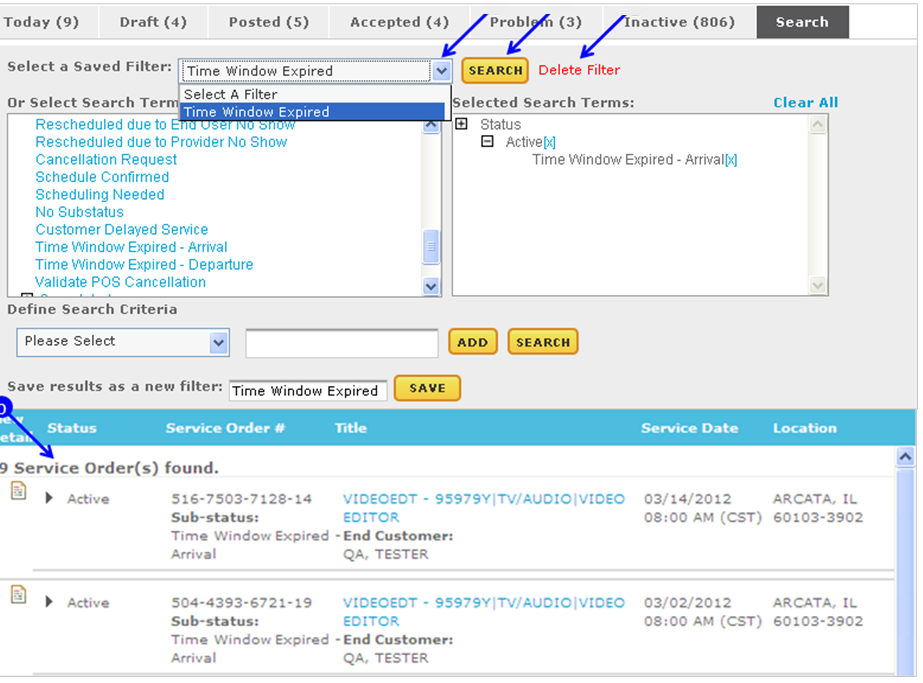This lesson explains steps to Search and Locate Service Orders. These steps will work for all search items you might want to use to search for Service Orders. You can search by Status of Service Orders: Posted, Completed, Problem, etc. You have the ability to define searches and Create Custom Search Filters. There are many ways to search and locate information in ServiceLive and as you become more familiar with ServiceLive, you will find other ways to accomplish steps detailed in this lesson.
- Lifecycle/Status of a Service Order:
- Drafted – After Buyer creates a new Service Order OR edits a Draft Service Order AND saves as Draft, Service Order will be located on Draft tab until Buyer Posts or Deletes Service Order. Provider will not be able to view until Buyer posts Service Order.
- Posted
- Buyer Posts a Name Your Price Service Order, which they identify price. Buyer can view from Posted Provider can view/take action from Received tab.
- Buyer Posts a Bid Request Service Order, which they ask for bids.
- Bid Requests functionality can be enabled in ServiceLive at Buyers request.
- If not enabled, Buyer will not see this tab.
- Buyer will be able to view Bid Request Service Orders from Posted Provider can view/take action from Bid Requests tab.
- Accepted – On Name Your Price, once Provider Accepts or Buyer Accepts Provider’s Counter Offer, Service Order will change to Accepted status and will be located on Accepted tab until Service Date/Time. On Bid Requests, once Buyer Accepts Bid, Service Order will change to Accepted status and will be located on Accepted tab until Service Date/Time.
- Active – Once the Service Date/Time occurs, Service Order will change to Active status and will be located on Today tab.
- Completed – Once Provider submits Service Order for payment, Service Order will change to Completed status and will be located on Today tab.
- Closed – Once Buyer Closes and Pays, Service Order will change to Closed status and will be located on Inactive tab.
- Service Orders can be in six other statuses: Cancelled, Voided and Deleted status located on Inactive tab, Pending Cancel and Expired status located on Today tab, and Problem status located on Problem tab.
- When you login to ServiceLive, the Dashboard tab will open.
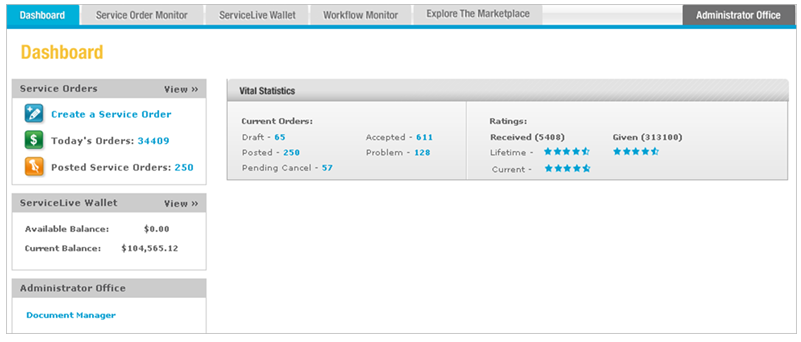
- Navigate to Search Tab:
Note: You can only access Search tab via Service Order Monitor.- Click on Service Order Monitor tab.
- Click on Search tab.

- Search and Locate Service Orders, so you can view or take action (i.e. you might want to locate Completed Service Orders to mark certain ones Closed).
- Click on
 (expand) button in front of appropriate search term OR click on appropriate search term (i.e. Status) in “Select Search Terms” box.
(expand) button in front of appropriate search term OR click on appropriate search term (i.e. Status) in “Select Search Terms” box. - This will display a list of selections (i.e. Statuses) available to select to refine your search.
Note: Any of the Search Terms in this box function the same way as described for Status. - Click on search term (i.e. Completed) to add to “Selected Search Terms” box on right side.
- Click on
 button, which is located next to
button, which is located next to  button.
button. - This will display all your Completed Service Orders.
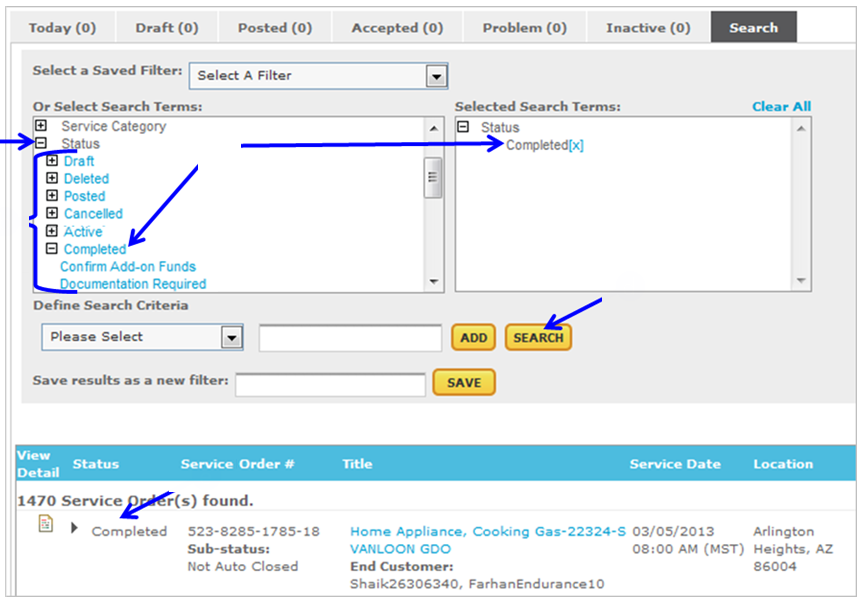
- Click on
- Clear Selected Search Items:
Note: You have the ability to change selected criterion by deleting search criteria.- Click on
 link behind the specific criteria to clear it.
link behind the specific criteria to clear it. - OR click on
 link to clear all search criteria and your search will be cleared.
link to clear all search criteria and your search will be cleared.
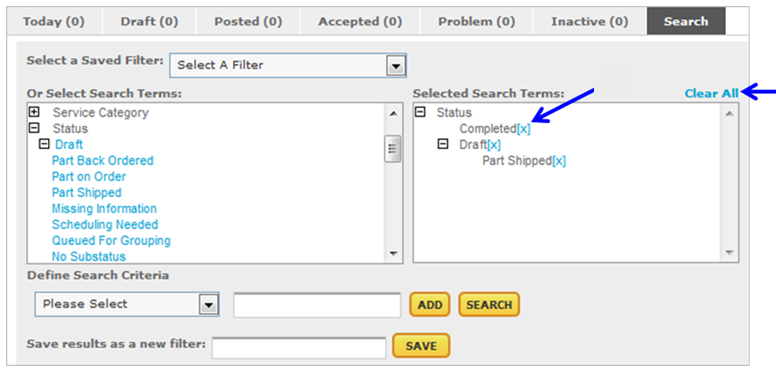
- Click on
- Search on Multiple Criterion:
Note: You will find an extensive list of possible ways to search for Service Orders. (A common multiple search might be to locate all Active and Accepted Service Orders if unsure what is Service Order status.)- Click on
 (expand) button in front of appropriate search term OR click on actual search term to expand choices.
(expand) button in front of appropriate search term OR click on actual search term to expand choices. - Click on
 (collapse) button in front of appropriate search term OR click on actual search term to collapse choices.
(collapse) button in front of appropriate search term OR click on actual search term to collapse choices. - Click on appropriate search term to add to “Selected Search Terms” box on right side.
Note: You have the ability to add multiple search terms by double clicking on search term. - Click on
 button, which is located next to
button, which is located next to  button.
button.
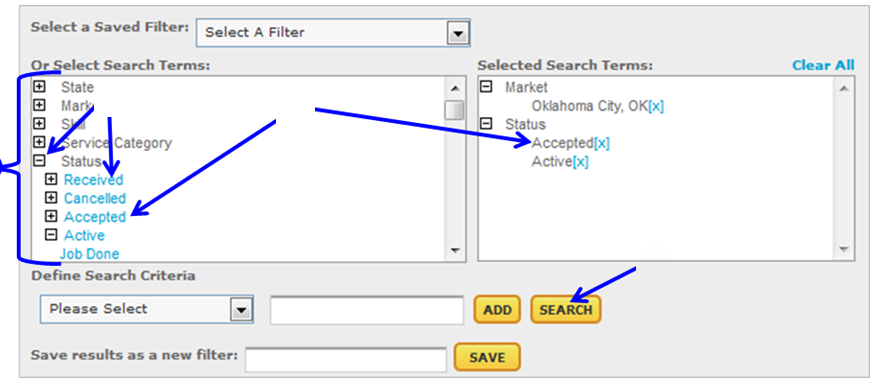
- This will display all Service Orders that meet your “Search Terms”.

- Click on
- Define Search Criteria:
Note: This provides the ability to Define Search Criteria by selecting appropriate choice from drop down list. An example where this might be useful would be if you want to search for all Service Orders for a specific Customer Name.- Click on drop down arrow to display list and select appropriate choice (i.e. Customer Name).
- Type appropriate information in box.
- Click on
 button.
button. - Search Criteria you add will appear in Selected Search Terms on right side.
- Click on
 button.
button.
Note: You have the ability to select single search criteria or add multiple search criteria. The advantage of utilizing multiple search criteria is you can find the information you want easier and quicker because you will have to look through fewer Service Orders. - You have option to Define Search Criteria by following above steps AND/OR
- You have option to also Select Search Terms by following Step 4 earlier in this lesson.
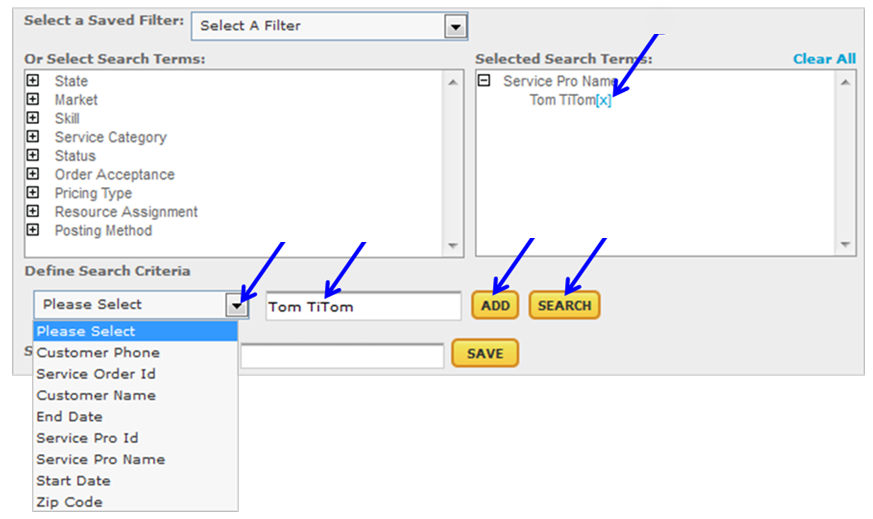
- Create/Save your own Search Filter:
You may find that there are certain searches that you want to use on a regular basis and you want to do without having to drill down through multiple search criteria. One example that many Buyers use is a search filter for Service Orders that Time Window Expired – Arrival.- Click on Status search term.
- Click on Active search term.
- Scroll down to locate appropriate choice.
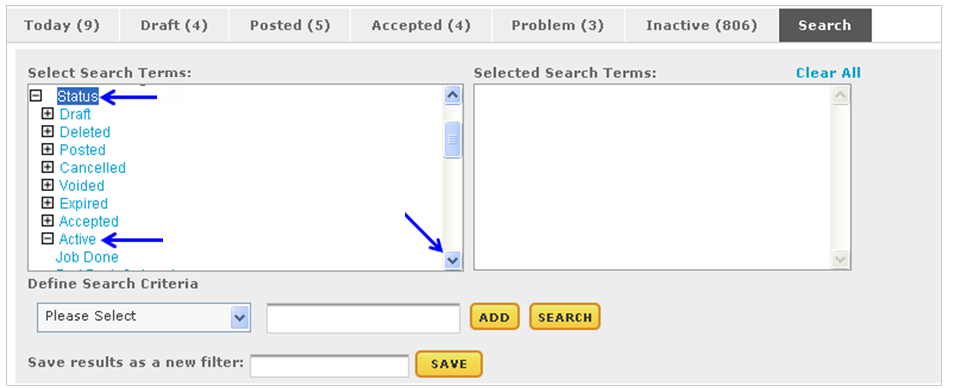
- Click on appropriate search term (i.e. Time Window Expired). This will add search criteria to Selected Search Terms on right side.
- Type name for your filter (i.e. Time Window Expired).
- Click on
 button.
button. - The saved filter will be available in Select a Saved Filter.
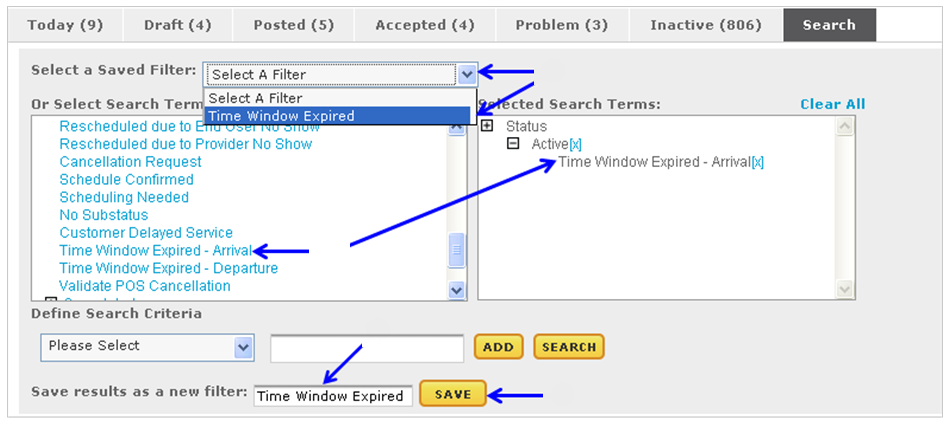
- Select/Delete a Saved Filter:
- Click on drop down arrow to view saved filters.
- Scroll down to locate appropriate choice (i.e. Time Window Expired) in drop down list, click to select appropriate choice (i.e. Time Window Expired).
- Click on
 button.
button. - This will display all Service Orders for the Filter you created. You will find this helpful anytime you search in ServiceLive to reduce items displayed to solely your Service Orders.
- To delete a saved filter, follow Steps a. – c., click on
 link.
link.
